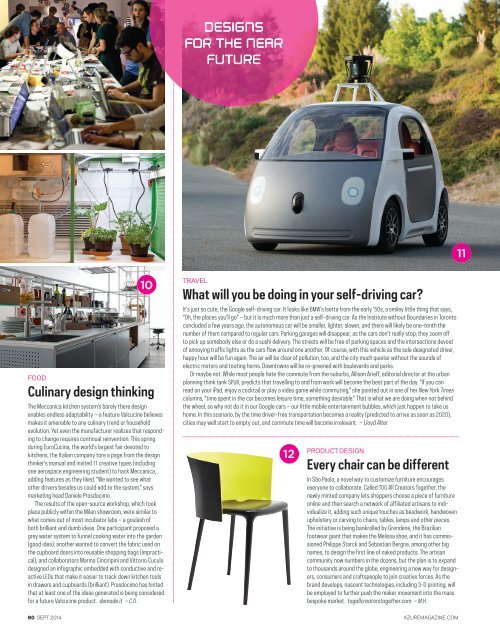AZURE_2014_09.pdf
Create successful ePaper yourself
Turn your PDF publications into a flip-book with our unique Google optimized e-Paper software.
designs<br />
for the near<br />
future<br />
11<br />
10<br />
FOOD<br />
Culinary design thinking<br />
The Meccanica kitchen system’s barely there design<br />
enables endless adaptability – a feature Valcucine believes<br />
makes it amenable to any culinary trend or household<br />
evolution. Yet even the manufacturer realizes that responding<br />
to change requires continual reinvention. This spring<br />
during EuroCucina, the world’s largest fair devoted to<br />
kitchens, the Italian company tore a page from the design<br />
thinker’s manual and invited 11 creative types (including<br />
one aerospace engineering student) to hack Meccanica,<br />
adding features as they liked. “We wanted to see what<br />
other drivers besides us could add to the system,” says<br />
marketing head Daniele Prosdocimo.<br />
The results of the open-source workshop, which took<br />
place publicly within the Milan showroom, were similar to<br />
what comes out of most incubator labs – a goulash of<br />
both brilliant and dumb ideas. One participant proposed a<br />
grey water system to funnel cooking water into the garden<br />
(good idea); another wanted to convert the fabric used on<br />
the cupboard doors into reusable shopping bags (impractical);<br />
and collab orators Marina Cinciripini and Vittorio Cuculo<br />
designed an infographic embedded with conductive and reactive<br />
LEDs that make it easier to track down kitchen tools<br />
in drawers and cupboards (brilliant). Prosdocimo has hinted<br />
that at least one of the ideas generated is being considered<br />
for a future Valcucine product. demode. it – C.O.<br />
travel<br />
What will you be doing in your self-driving car?<br />
It’s just so cute, the Google self-driving car. It looks like BMW’s Isetta from the early ’50s, a smiley little thing that says,<br />
“Oh, the places you’ll go” – but it is much more than just a self-driving car. As the Institute without Boundaries in Toronto<br />
concluded a few years ago, the autonomous car will be smaller, lighter, slower, and there will likely be one-tenth the<br />
number of them compared to regular cars. Parking garages will disappear, as the cars don’t really stop; they zoom off<br />
to pick up somebody else or do a sushi delivery. The streets will be free of parking spaces and the intersections devoid<br />
of annoying traffic lights as the cars flow around one another. Of course, with this vehicle as the sole designated driver,<br />
happy hour will be fun again. The air will be clear of pollution, too, and the city much quieter without the sounds of<br />
electric motors and tooting horns. Downtowns will be re-greened with boulevards and parks.<br />
Or maybe not. While most people hate the commute from the suburbs, Allison Arieff, editorial director at the urban<br />
planning think tank SPUR, predicts that travelling to and from work will become the best part of the day. “If you can<br />
read on your iPad, enjoy a cocktail or play a video game while commuting,” she pointed out in one of her New York Times<br />
columns, “time spent in the car becomes leisure time, something desirable.” That is what we are doing when not behind<br />
the wheel, so why not do it in our Google cars – our little mobile entertainment bubbles, which just happen to take us<br />
home. In this scenario, by the time driver-free transportation becomes a reality (predicted to arrive as soon as 2020),<br />
cities may well start to empty out, and commute time will become irrelevant. – Lloyd Alter<br />
12<br />
product design<br />
Every chair can be different<br />
In São Paolo, a novel way to customize furniture encourages<br />
every one to collaborate. Called TOG All Creators Together, the<br />
newly minted company lets shoppers choose a piece of furniture<br />
online and then search a network of affiliated artisans to individualize<br />
it, adding such unique touches as beadwork, handwoven<br />
upholstery or carving to chairs, tables, lamps and other pieces.<br />
The initiative is being bankrolled by Grendene, the Brazilian<br />
footwear giant that makes the Melissa shoe, and it has commissioned<br />
Philippe Starck and Sebastian Bergne, among other big<br />
names, to design the first line of naked products. The artisan<br />
community now numbers in the dozens, but the plan is to expand<br />
to thousands around the globe, engineering a new way for designers,<br />
consumers and craftspeople to join creative forces. As the<br />
brand develops, nascent technologies, including 3‐D printing, will<br />
be employed to further push the maker movement into the mass<br />
bespoke market. togallcreatorstogether. com – M.H.<br />
80 sept <strong>2014</strong> azuremagazine.com


















